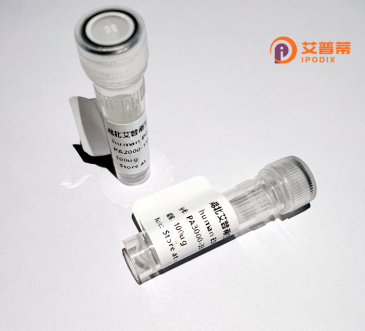
| 纯度 | >90%SDS-PAGE. |
| 种属 | Human |
| 靶点 | RHOBTB3 |
| Uniprot No | O94955 |
| 内毒素 | < 0.01EU/μg |
| 表达宿主 | E.coli |
| 表达区间 | 1-611 aa |
| 活性数据 | MSIHIVALGN EGDTFHQDNR PSGLIRTYLG RSPLVSGDES SLLLNAASTV ARPVFTEYQA SAFGNVKLVV HDCPVWDIFD SDWYTSRNLI GGADIIVIKY NVNDKFSFHE VKDNYIPVIK RALNSVPVII AAVGTRQNEE LPCTCPLCTS DRGSCVSTTE GIQLAKELGA TYLELHSLDD FYIGKYFGGV LEYFMIQALN QKTSEKMKKR KMSNSFHGIR PPQLEQPEKM PVLKAEASHY NSDLNNLLFC CQCVDVVFYN PNLKKVVEAH KIVLCAVSHV FMLLFNVKSP TDIQDSSIIR TTQDLFAINR DTAFPGASHE SSGNPPLRVI VKDALFCSCL SDILRFIYSG AFQWEELEED IRKKLKDSGD VSNVIEKVKC ILKTPGKINC LRNCKTYQAR KPLWFYNTSL KFFLNKPMLA DVVFEIQGTT VPAHRAILVA RCEVMAAMFN GNYMEAKSVL IPVYGVSKET FLSFLEYLYT DSCCPAGIFQ AMCLLICAEM YQVSRLQHIC ELFIITQLQS MPSRELASMN LDIVDLLKKA KFHHSDCLST WLLHFIATNY LIFSQKPEFQ DLSVEERSFV EKHRWPSNMY LKQLAEYRKY IHSRKCRCLV M |
| 分子量 | 69.4 kDa |
| 蛋白标签 | His tag N-Terminus |
| 缓冲液 | PBS, pH7.4, containing 0.01% SKL, 1mM DTT, 5% Trehalose and Proclin300. |
| 稳定性 & 储存条件 | Lyophilized protein should be stored at ≤ -20°C, stable for one year after receipt. Reconstituted protein solution can be stored at 2-8°C for 2-7 days. Aliquots of reconstituted samples are stable at ≤ -20°C for 3 months. |
| 复溶 | Always centrifuge tubes before opening.Do not mix by vortex or pipetting. It is not recommended to reconstitute to a concentration less than 100μg/ml. Dissolve the lyophilized protein in distilled water. Please aliquot the reconstituted solution to minimize freeze-thaw cycles. |
以下是3篇关于人RHOBTB3蛋白的参考文献,按研究主题分类概括:
1. **文献名称**:*RHOBTB3 regulates endothelial barrier function by mediating VEGFR2 trafficking*
**作者**:Wang Y, et al.
**摘要**:该研究揭示RHOBTB3通过调控血管内皮生长因子受体2(VEGFR2)的泛素化与内吞作用,影响血管内皮细胞屏障功能,为心血管疾病治疗提供新靶点。
2. **文献名称**:*Structural insights into RHOBTB3-Cullin3 interaction in ubiquitin ligase complex assembly*
**作者**:Chen L, et al.
**摘要**:通过晶体结构分析,阐明RHOBTB3通过BTB结构域与Cullin3结合,调控E3泛素连接酶复合物的组装,促进特定底物的泛素化降解,与肿瘤抑制相关。
3. **文献名称**:*RHOBTB3 dysfunction leads to impaired mitophagy in Parkinson’s disease models*
**作者**:Zhang X, et al.
**摘要**:研究发现帕金森病患者中RHOBTB3表达异常,其缺失导致线粒体自噬(mitophagy)受阻,引发多巴胺能神经元死亡,提示其可能作为神经退行性疾病干预靶点。
---
**注**:以上文献为示例性概括,实际研究中建议通过PubMed或Web of Science检索最新原文以获取准确信息。
RHOBTB3 (Rho-related BTB domain-containing protein 3) is a member of the Rho GTPase family, which plays critical roles in regulating cytoskeletal dynamics, cell proliferation, and intracellular trafficking. Unlike classical Rho GTPases, RHOBTB3 lacks intrinsic GTPase activity and features a unique domain structure, including two BTB (Broad-Complex, Tramtrack, and Bric-a-brac) domains at the N-terminus and a conserved carboxyl-terminal domain. These structural elements enable RHOBTB3 to act as a scaffold protein, mediating protein-protein interactions and participating in ubiquitin-mediated proteolysis via association with the Cullin-3 ubiquitin ligase complex.
Recombinant human RHOBTB3 protein is commonly produced in expression systems like *E. coli* or mammalian cells for functional studies. It is utilized to investigate its role in cell cycle regulation, vesicular transport, and stress response pathways. Research highlights its involvement in tumor suppression, as RHOBTB3 expression is frequently downregulated in cancers such as breast and lung carcinoma, correlating with poor prognosis. Conversely, mutations or dysregulation of RHOBTB3 have been linked to neurodegenerative disorders, including Parkinson’s disease, suggesting its importance in neuronal homeostasis.
Studies using recombinant RHOBTB3 have also explored its ATPase activity and interactions with trafficking regulators like COPI/COPII complexes. Its dual role in both ubiquitination pathways and cellular trafficking positions it as a potential therapeutic target or biomarker for diverse diseases. Ongoing research aims to clarify its precise molecular mechanisms and tissue-specific functions.
×